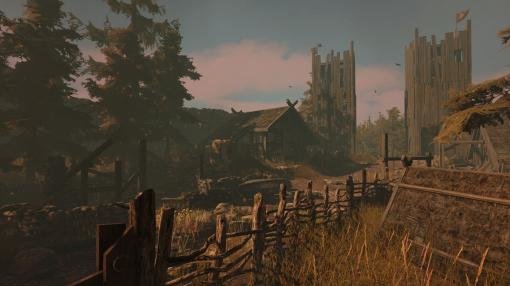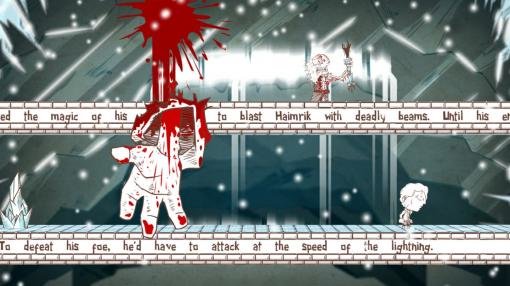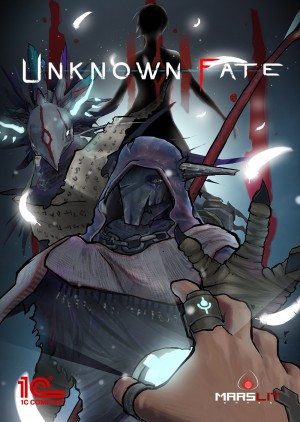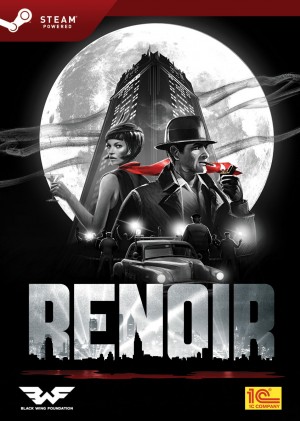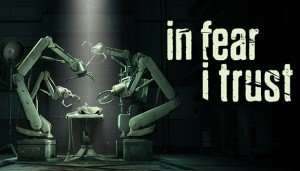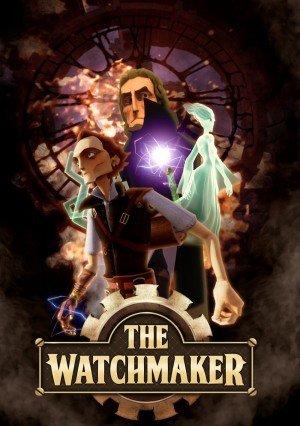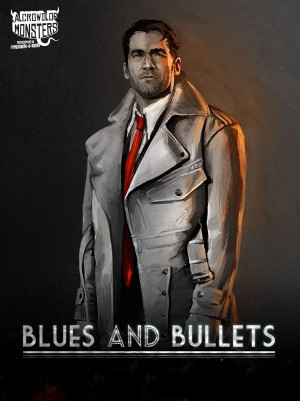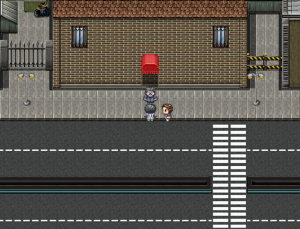Gamescom 2016 round-up - 1C Company
Events Coverage
Reporting from E3, GDC, AdventureX, Gamescom and other gaming events around the world

When I made my gamescom appointment with 1C Publishing, I was told to “bring some time”. And for good reason, as the Russian company’s portfolio of upcoming adventure games (or at least “adventure-like” in some cases) is enormous. During a short briefing, PR manager Jan Olejník told me that 1C extensively searched for promising independent projects, and met with developers from all over the world to sign their games. After asking me which titles I’d like to learn more about, Jan showed me several trailers and gameplay videos, quickly summarizing each project. Afterwards I left for the demo area to find out which of the discussed games were playable. I also had the opportunity to chat with two of the development teams. The following round-up includes the many games I researched at the booth of 1C Publishing.
Through the Woods
Developed by Norwegian studio Antagonist, Through the Woods is heavily inspired by Norse mythology and the legends of Ragnarök in particular. The game is a third-person horror adventure set in an eerie forest in Norway, telling the story of a mother searching for her son who’s been kidnapped by a mysterious elder man called “Old Erik”. From the beginning we know that the heroine is re-telling these events to someone, but at this point we don’t know who that person is.
I had the chance for a quick chat with writer, sound designer, and composer Dan Wakefield. Afterwards, I was able to get my hands on the demo for several minutes. Citing gameplay similarities to Amnesia, the Norwegian developer also brought up a connection with Gone Home. During the exploration of the woods, searching for clues to the missing son, there are lots of documents to be found that reveal the history of Old Erik and the game’s island setting. Before the demo started, Dan told me that Through the Woods does not focus on jump scares, but rather that “the haunting atmosphere is the key to the experience. We have captured the feeling of the forest as we saw it as children, with all the fear and mystery that comes from roaming through it alone.”
As I put on headphones and started playing, I realized that Dan’s words were a spot-on introduction. Walking through the nocturnal forest, a variety of details made this dark place come to life. Sounds of a thunderstorm, fluttering leaves on huge trees, bushes blowing in the wind, ominous shadows (that vanished as suddenly as they appeared) and unidentifiable noises culminated in an oppressive feeling of impending doom. I had no doubt that something was out there to get me, and whatever it was, I was entirely alone with it.
Armed only with a flashlight, I first entered a few wood cabins to read documents, and I encountered some Norse rune stones that served as save points. As I arrived at an old abandoned village, I ventured into one of the buildings. My anxiety reached a new level when the door shut behind me suddenly. Hearing menacing noises once more, I couldn’t see anyone except for the playable character. Yet I felt an enormous urge to get out of there and just run as far as I could. Once I managed to escape, I started running indeed. It didn’t take long before I spotted a huge troll that slowly started moving into my direction. Being chased by the very unpleasant creature I just ran, ran, ran, and was kind of relieved that I had to leave for my next appointment before I ended up as the troll’s dinner.
“Holy crap – that was intense!” were the first words I said to Dan after stripping off the headphones. “The game is not about combat,” he told me when I asked him about action elements, adding that with several horrific creatures present, “sneaking and avoiding being spotted is the way to go.” I can’t comment much about the gameplay or judge the overall quality of the main story, but I was gripped by the demo’s atmosphere and excellent sound design. The last time a forest made me feel this uneasy was when I watched Lars von Trier’s notorious horror drama Antichrist.
Through the Woods is currently aiming for a Windows release in October, so if you like the idea of a moody, psychological adventure centered on Norse mythology, you might not want to miss this one.
Haimrik
The side-scrolling puzzle adventure Haimrik was another playable title at 1C’s demo area. Developed by Colombian studio Below the Game, this unusual project stars a young scribe named Haimrik, who lives in a medieval world with sorcerers and dragons. When Haimrik discovers a magic book, he learns how to bring words to life and uses his new power to fight an evil king and his henchmen. After briefly playing the game for myself, I also got the opportunity to meet with two members of the development team and dig a little deeper.
Haimrik presents a 2D sepia-toned world, giving the game a unique look. As I soon found out, though, the puzzle design is every bit as distinctive. The floor beneath Haimrik consists of words, and whenever you stand still on top of a particular word, you cause its associated action. A very simple example is stepping on top of the word “door”, which results in the appearance of a door. As the door is closed, you’ll need to find a way of opening it. So in this example you’ll have to step on the word “key” to materialize the word. Another example is stepping on the word “fire”. You’ll get burned, and somehow need to put out the fire. The easiest choice seemed to be stepping on the word “rain”. However, as Carlos Rocha (CEO/game design) told me, there are other options, too. Comparable to traditional inventory puzzles, he explained that it is just as possible to combine two words that create an object to suffocate the fire.
The demo used rather straightforward examples of the game’s mechanics to introduce the overall concept, but Carlos told me that “the game is challenging. Not in a way that it’s unplayable for most people. However, it challenges your brain to think about how to solve the puzzles in a very creative way.” This also means the protagonist might die several times before you learn how to overcome a tricky obstacle. Later in the game, Haimrik will be joined by a sidekick named Masamba. While I did not see the lioness myself, I was told that “Masamba will protect Haimrik from harm... when she’s not trying to eat him.” In fact, Masamba will have a crucial impact on gameplay at various points, as “basically you hop on top of her and are able to fight other guardian animals from the other Word Warriors, like the dragon or a polar bear made of ice.”
Haimrik does involve some combat, but this too is at least partially related to the power of words. If a soldier tries to kill you, for instance, you can activate words such as “sword” or “spear” to grab the particular weapon. You can’t rely totally on words for protection, however. Carlos underlined this in saying that “the player actually has to fight; we give him options like an attack button, a dash forward and backwards to increase movement and options, and throwing your weapon at your enemies, with enemies being stronger as the game progresses."
The black-humored game contains several elements of over-the-top violence. As blood is portrayed in its actual color, the sepia backgrounds repeatedly get splattered in red. “The gory part and dark humor comes from influences like (The Simpsons’) Itchy & Scratchy, for instance, or Happy Tree Friends,” Below the Game’s Diana Garcia (legal and human resources) told me that “the dark humor is a very significant signature in our work.” Asked for other influences, Diana pointed out a strong interest in European history and literature, including George R.R. Martin’s A Song of Ice and Fire, the latter “particularly because of the violence and sudden twists in the story that engage the player.”
While it certainly isn’t a traditional adventure by any means, Haimrik is one of the titles I saw at gamescom that stood out for its unique and clever approach to gameplay. Though I only played the demo for a short time, it was more than enough to leave an excellent impression on me. Let’s hope the final product does justice to its potential when the game releases for PC and PS4 sometime in 2017.
Unknown Fate
1C’s Jan Olejník revealed that one of the company’s most recent signings was Unknown Fate, from Italian developer MarsLit Games, pitching it as an “enigmatic story-driven first-person adventure.” Unfortunately it was not playable at the demo area, so instead Jan showed me the beginning of the game as an in-game video. With the exception of one environmental puzzle, most of what I observed consisted solely of 3D exploration, but Jan assured me that there will be many more puzzles throughout the course of the game. There will also be “boss fights” that all require a different strategy to overcome. I tried to find out more about this aspect of the game, but wasn’t able to do so “for the sake of spoilers.” Nevertheless, I was told that “this is an adventure game with a strong story, so action is not the main point of the game.”
The opening sequence turned out to be as surreal as it was intimidating. At first, it seemed like the unseen player was investigating a perfectly normal middle-class neighborhood. Very soon I realized, however, that parts of the scenery had vanished. At the same time, a bizarre path emerged that 1C’s PR manager told me would lead deeper into the main character’s subconscious. As one world seemed to be swallowing the other, the protagonist followed the path and I witnessed strange sights in the sky, such as a huge spider and an enormous whale passing by. During the rest of the video, we progressed deeper into the character’s psychological world. This allowed me to see several other eerie mind projections, some of them seemingly based on childhood memories. According to Jan, Unknown Fate has a philosophical background, and revealing very particular things about the character’s past will be of great importance.
Everything I saw of Unknown Fate took place at night, which further added to the element of surrealism. Every location used different lighting effects, some of them very moody, to enhance the game’s dream-like atmosphere. I’m under the impression that the blending of light and darkness might be an important aspect of the full game.
The surreal entrance to the protagonist’s subconscious fascinated me and was very well executed. I did not see enough actual gameplay to get a good idea of the overall design, but early impressions are promising and perhaps there will be a chance for a closer look before the game releases sometime next year. Unknown Fate will support Oculus Rift as well as HTC Vive, though non-VR versions will also be released on PC, PS4 and Xbox One.
Renoir
Renoir is described as a “story-driven 2D platformer drawing inspirations from 1940s film noir.” While the announcement trailer didn’t contain any gameplay material, it did demonstrate the game’s comic-like cutscenes and stylish black-and-white presentation. Being a fan of old American detective movies, I must say that the protagonist’s video monologue seemed quite clichéd to me. However, due to the atmospheric visuals and their interesting ways of blending light and darkness, I was eager to find out more about the project and its gameplay.
Developed by Black Wing Foundation, a company registered in Estonia, the keyboard-controlled game stars a former cop named James Renoir, who for years fought organized crime in a dark and violent metropolis. Since the mafia’s influence even extended to the police and government, it seemed like Renoir was fighting a losing battle. But things changed when a young aspiring politician teamed up with him to finally clean up the city. At the same time, James also met the love of his life, so it appeared that his life was taking a turn in the right direction… until he was murdered.
Crediting Capcom’s Ghost Trick: Phantom Detective as an influence, PR manager Jan Olejník launched a short gameplay video and explained what happens after Renoir’s violent departure. Risen from the grave, the former detective has turned into a ghost with a single-minded purpose: finding out who killed him, and getting revenge. When asked whether that might include shooting enemies, Jan told me that Renoir is treading a very different direction. According to him, and reinforced by what I saw personally, the side-scrolling game focuses on puzzle solving while the backstory unfolds. Having to avoid light at all costs, Renoir is able to take control of phantoms. These phantoms play a crucial role in the environmental puzzles that need to be solved for you to progress to the next part of the screen.
Admittedly, I didn’t have enough time for a hands-on glimpse at Renoir, so it’s hard to assess how important the narrative elements really are. Still, the game seems to feature a very promising puzzle approach, not to mention its stylish and atmospheric look. Just like the cutscenes, the actual game, built with the Unreal Engine 4, uses a very “noir-ish” monochromatic presentation. If that sounds like a good combination to you, keep an eye out for the game’s PC release in November.
And More! (In Fear I Trust, The Watchmaker)
I was only able to see trailers for two other potentially interesting games being published by 1C, but both are deserving of at least a brief mention.
In Fear I Trust is a first-person horror adventure by Black Wing Foundation, developers of Renoir, letting players unravel the truth behind a secret Soviet experiment. Offering “puzzle solving and the exploration of eerie locations”, In Fear I Trust uses comic-style cutscenes to unfold some of its story. While the game has already been released episodically for iOS and Android, a complete PC version is planned for launch on the 20th of September.
The other game in question is The Watchmaker. No relation to Trecision's 2001 adventure by the same name, this is a hybrid containing elements of exploration, puzzle solving, and also platforming action and boss fights. Players take on the role of Alexander, who lives in a steampunk-style tower full of giant clock mechanisms. Each day Alexander’s routine involves adjusting its mechanisms to maintain and repair his precious tower, until one day someone sabotages it. With the clock not working properly, time spins out of control and Alexander starts aging abnormally quickly. With very little time to repair the damage, and armed only with "a magnetic glove and a bag of time bombs", Alexander must collect bits of time to regenerate his youth as he presses on through the tower in order to unravel its secrets. Developed by Micropsia Games, The Watchmaker is targeting a release for PS4, Xbox One, and Windows sometime in 2017.


